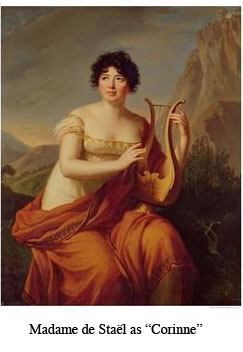|
Persuasions #13, 1991 Pages 39-40
Jane
Austen and Madame de StaŽl C. F. VIVEASH Swindon, Wiltshire, England
ďIn the immense crowds that collected to see her at the Marquis of
Lansdowneís [house], Ö the eagerness of curiosity broke through all restraint;
the first ladies in the kingdom stood on chairs and tables to catch a glimpse
of her dark and brilliant physiognomy.Ē1†
Thus Madame de StaŽl had arrived in London in June 1813, and was
received with enthusiastic admiration.†
Her genius, her fame, her escape from Napoleon, her reputation had
preceded her, and Society came to pay homage. 
Just four months later Jane Austen was quietly
visiting her brother Henry in London, and he was pleased to advise her that ďa
nobleman, personally unknown to her Ö was desirous of her joining a literary
circle at his houseĒ and ďthat the celebrated Madame de StaŽl would be of the
party.Ē2† Unhesitatingly Jane
refused the invitation.† ďTo her truly
delicate mind such a display would have given pain instead of pleasure,Ē3
wrote Henry some fifteen years after her death.† It has also been suggested that Jane refused to meet the lady
because of her notorious love affairs and her unrelenting chatter;4
but, whatever the reason, Jane demurred. Madame de StaŽl, certainly, was formidable,
with a background very different from Jane Austenís.† Anne Marie Louise Germaine Necker was the daughter of a famous
French Minister of Finance, Jacques Necker.†
Her mother was Susanna Curchod, and it was she who educated Germaine
beyond her years.† As Jane Austen showed
early promise, so did Germaine, who wrote and produced drawing-room plays for
her family, publishing in 1787, when she was twenty-one, Sophia, or Secret
sentiments, a comedy.† Her parents
arranged her marriage in 1786 to Baron de StaŽl Holstein, the Swedish
Ambassador to Paris, who was to receive £80,000 as dowry money from M. Necker.† Some years later Madame de
StaŽl was to remark, ďI will force my daughter to make a marriage of inclinationĒ,
this poignant comment came during the loveless years of her first
marriage.† Her situation enabled her to
watch at first hand the violent removal of Louis XVI and the events leading up
to the French Revolution.† The Comte de
Feuillide, husband of Jane Austenís cousin Eliza Hancock, was executed shortly
after Madame de StaŽl had braved the wrath of the Paris mob by publishing a
spirited appeal to the French nation to save Marie Antoinette.† Many fugitives were given shelter by Madame
de StaŽl, and she was instrumental in saving lives (hoping that the French
residence of a foreign ambassador would not be searched).5 But what of her person?† Captain Gronow describes her as ďa large,
masculine looking woman, rather coarse with a thoracic development worthy of a
wet nurse.† She had very fine arms which
she took every opportunity of displaying, dark flashing eyes beaming with wit
& genius.Ē6† Statesmen,
men of science, poets, lawyers were astounded by her eloquence and
erudition.† Wellington, Lafayette,
Talleyrand, Prince Laval all attended Madame de StaŽlís salons, and found her
irresistible.† She astonished everyone
by taking as a second husband in 1811, M. de Rocca, a dashing young officer who
had earlier boasted, ďI will love her so devotedly that she cannot
refuse to marry me!Ē7†
Romance and excitement surrounded her and gave London a new sideshow
during 1813.† Small wonder that Jane
Austen said no! Henry Colburn, the publisher, lent a copy of Pride
and Prejudice to Madame de StaŽl, who dismissed it as ďvulgaire,Ē and yet
she sought a copy of Mansfield Park for her home library at Coppet.8† Madame de StaŽl was considered the premier
authoress of Europe, Lord Macaulay calling her the ďfirst woman of her ageĒ9
and Byron adding ďMadame de StaŽl is as brilliant as ever.Ē10† Yet the intervening years have reversed this
position.† Readers across the world have
been more fascinated by the everyday events in Highbury or Meryton, than by the
grand sweep of Corinneís Italy.† During
Madame de StaŽlís final illness the Duke of Wellington came daily to ask if
there was no hope;11 Jane Austen had but her dear sister Cassandra
to attend her.† Sadly, both authoresses
died during July 1817, prompting the Gentlemanís Magazine to devote
three pages of obituary notices to Madame de StaŽl and just three lines to Jane
Austen.12 † The color image has replaced the original black and white image for the on-line edition of this essay. – C. Moss, JASNA Web Site Manager NOTES 1 Isabel Hill, ďMemoir of Madame de StaŽl,Ē
prefaced to Corinne (London: Richard Bentley, 1833), p. xliv. 2 Henry Austen, ďMemoir of Miss Austen,Ē
prefaced to Sense and Sensibility (London: Richard Bentley, 1833), p.
ix. 3 Ibid. 4 Lord David Cecil, A Portrait of Jane Austen
(London: Constable, 1978), p. 179. 5 Isabel Hill, pp. xviii-xx. 6 Captain Gronow, The Reminiscences of
Captain Gronow, edited by Nicolas Bentley (London: The Folio Society,
1977), pp. 128-129. 7 Isabel Hill, p. xxxiv. 8 David Gilson, A Bibliography of Jane Austen
(Oxford: Clarendon Press, 1982), pp. 26, 476, 135. 9 David Gilson, p. 477. 10 Isabel Hill, p. 1. 11 Isabel Hill, p. li. 12 David Gilson, p. 471. |
